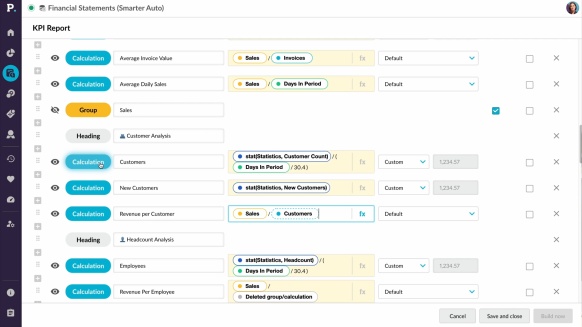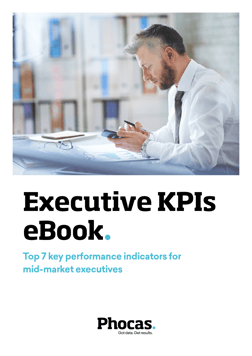Business KPIs: 5 important characteristics to be effective

To remain competitive, business managers need to track how company-wide goals are regularly progressing. Setting business key performance indicators (KPIs) is one of the easiest ways to do this. Unfortunately, many people get their business KPIs wrong, by measuring too much, focusing on the unhelpful types of KPIs or copying the metrics others are using.
What is a KPI?
A Key Performance Indicator (KPI) is a quantifiable measure used to evaluate the success or performance of a business in relation to its strategic goals and objectives. KPIs are typically aligned with a company's key priorities, and they provide a clear and concise way to track progress and identify areas for improvement.
What makes a good KPI?
For KPIs to be effective, it’s essential that managers consider what they need to know and then set business KPIs to measure their specific strategy.
Read on to find out the five features that make an effective KPI and how to measure them in your business.
Simple
A good KPI should be simple, straightforward and easy to measure. Business analytics expert Jay Liebowitz says that an effective KPI is one that “prompts decisions, not additional questions.” For example, “How many customers did we add this quarter?” is clear and simple.
Everyone involved in a goal should be able to recognize their role in enacting a KPI. If a goal is clear, people can make practical decisions that lead to achieving the and exceeding business goals.
Relevant
As important as it is for a KPI to be simple, it must also be relevant to a specific team or strategy within an organization. A question such as, “Are people who are buying printers also buying ink?” is most useful for sales managers. This KPI can help the sales manager better understand where additional cross-sell opportunities lie within an existing customer base.
Relevance ensures the right decision makers are responsible for measuring specific KPIs — increasing the likelihood of a successful outcome.
Aligned
KPIs should always trickle down from the overall strategic goals of an organization. As a result, they need to be aligned and not unintentionally undermine each other.
While some organizations focus on attracting and acquiring an ever-growing number of new customers, for other businesses this may not work inside the overall vision.
For example, a business that places emphasis on customer satisfaction would have a more central focus on customer retention than new customer acquisition costs. An example of a Customer Experience KPI for this type of business might be, “How many clients has sales rep X visited this month?”
Make sure that KPIs are always supporting the overall strategy of the organization.
Actionable
It’s no use tracking KPIs for the sake of it. Managers must build business KPIs that positively affect the company. As such, not only should they be easy to understand, but teams should also know how to achieve an effective outcome. Tracking unachievable goals can be a big de-motivator for employees.
Leading KPIs are just that, performance measures that are known to result in a positive outcome that can be measured as a lagging KPI in a month’s time. The more realistic the goal of a KPI is, the more achievable it is for your teams.
Instead of setting large, complex and lagging KPIs that can take time to report on, an organization might want to start small. Think “contact customers every X months” rather than “reduce customer turnover rates by Y%”. By setting KPIs that challenge employees and are easier to report, an organization can not only track the progress of a business KPI closely, but also boost employee satisfaction.
Measurable
It might seem obvious, but the best KPIs are easy to measure. An effective KPI avoids generalized goals like, “Improvement in warehouse department.” Instead, an effective KPI should be based on a solid, focused goal that can produce qualitative and quantifiable measures. A good inventory optimization example could be to "decrease dead stock by 20% within the next quarter". But it’s not much help you can only measure a KPI occasionally, making it a lagging indicator of good business performance.
A good way to reduce the lag of KPI measurement is with a an all-in-one BI & FP&A software solution that will aggregate all your data from various systems, giving you you a single source of truth and making data quick and easy to analyze. The right BI & FP&A solution will let you ask questions of your data to make critical decisions based on facts rather than gut feel.
Not only will you be better placed to accurately and effectively measure your business KPIs, you will also have more detailed insights into how your business is performing, leading to more informed forecasts and decision making.
Going back to the deadstock example above: If it's easy to get daily updates on stock levels, your team will be empowered to quickly pivot marketing strategies or change pricing to get stock sold and hit targets before it becomes a bigger problem.
So what about tracking employee performance?
Performance management is crucial for ensuring your team members are aligned with organizational goals and objectives. By effectively monitoring and evaluating employee performance, businesses can identify areas for improvement and take proactive measures to enhance productivity and employee satisfaction.
Implementing performance management processes involves regular performance reviews, appraisals and assessments. This enables you to set goals and milestones, outline clear expectations, track progress, provide regular feedback, and recognize and reward employees for their achievements. High-performing employees can also serve as role models and mentors to their peers, fostering a culture of continuous improvement and development.
Performance management can play a vital role in reducing employee turnover rates by addressing issues proactively and providing support and resources to help make goals more attainable. By actively engaging with employees and addressing their concerns, organizations can boost employee satisfaction and retention, ultimately leading to improved business outcomes. Through effective performance management strategies, businesses can optimize their human resources and drive long-term success.
Choosing the right BI and FP&A solution to measure your KPIs
More and more businesses are recognizing the importance of data analytics in helping them stay competitive, but it can be tricky to find a solution that delivers the exact KPI reports and KPI dashboards that you need. While some vendors offer BI tools with prebuilt dashboards and scorecard templates, it can be difficult to adapt them to suit your business. Phocas offers a whole-of-business BI and FP&A solution that can be used by anyone in the company to consolidate financial and non-financial data and report on both. Its a BI and FP&A platform that can be easily modified to suit your business objectives.
Phocas is an intuitive, user-friendly solution for all skill levels that becomes your single source of truth.
To learn more about the most effective business KPIs, and how you can use them to improve your business, download a free copy of our eBook ‘The top 7 KPIs for CEOs and Executives’.

Empowering businesses with intuitive data analytics, driving informed decisions for growth and profitability. We make people feel good about data.

The best financial KPIs for the distribution industry
Finance professionals in distribution businesses face a persistent challenge. That is to effectively blend operational and financial data to gain a complete picture of company performance. Traditional financial ratios often exist in isolation, making it difficult to assess the broader impact of operational decisions on financial outcomes.
Read more
Key sales KPIs for distribution companies
Managing sales in a distribution business without measuring key performance indicators (KPIs) is like maintaining your home without tools or a schedule. You don’t notice a leak until the damage is severe. Instead of making progress, you waste time searching for the right tools or calling an expert for simple fixes. Without the right KPIs, inefficiencies can go unnoticed, leading to cashflow issues and lost sales.
Read more
Essential KPIs every distribution company executive should measure
For mid-market leaders running a wholesale distribution business, data and business intelligence technology are crucial for monitoring financial and operational performance. However, the real value lies in how your team uses the data insights to influence decision-making.
Read more
5 key FP&A trends for 2025
The role of the CFO is evolving rapidly, extending beyond traditional financial stewardship to encompass business partnering, operational oversight and technological innovation. A 2024 Sage study of over 1,200 global finance leaders reinforces this transformation:
Read more
Find out how our platform gives you the visibility you need to get more done.
Get your demo today
